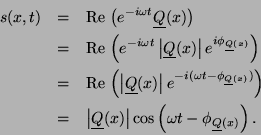| (1) |
To introduce the use of the complex representation for waves, we first
consider a sinusoidal pulse of the form
Next, we consider the form of a traveling wave solution made from such
a pulse,

An important way of understanding the complex amplitude function
![]() is to consider changes in the motion of a wave
wave relative to its motion at a reference point
is to consider changes in the motion of a wave
wave relative to its motion at a reference point ![]() . To do this, we
rewrite (2) as
. To do this, we
rewrite (2) as
In the plane wave motion we consider here, a traveling wave moves
along as a fixed shape, and so we expect the amplitude of the motion,
(max - min)/2, to be constant for each point in space. (As waves
spread outward from a point, as in the next set of notes, we in
general can expect a decay in amplitude with distance.) The
constantness of the amplitude corresponds to the fact that the
propagation factor ![]() has amplitude
has amplitude
![]() . Next, we generally do expect there
to be a change in phase when moving from the point
. Next, we generally do expect there
to be a change in phase when moving from the point ![]() to the point
to the point ![]() because
there is a time delay for maxima passing
because
there is a time delay for maxima passing ![]() to reach
to reach ![]() . The time delay for traveling the distance
. The time delay for traveling the distance ![]() is
is
![]() . To convert this to a phase in radians, we measure the delay in periods
and multiply by
. To convert this to a phase in radians, we measure the delay in periods
and multiply by ![]() :
:
![]() , precisely the phase appearing in the phase factor
, precisely the phase appearing in the phase factor
![]() .
Thus, the propagation factor
.
Thus, the propagation factor ![]() corresponds precisely to
the phase delay as
wave peaks pass
corresponds precisely to
the phase delay as
wave peaks pass ![]() propagating along to
propagating along to ![]() . Note that the above argument
is unaffected by whether the distance
. Note that the above argument
is unaffected by whether the distance ![]() is
traveled from left to right or from right to left. We thus have the
following rule,
is
traveled from left to right or from right to left. We thus have the
following rule,
Propagation factor:
The effect of propagating a wave a distance(measured as a positive value whether the wave moves to the right or left) appears in the complex representation as multiplication by the complex phase factor
. For plane waves and waves moving in one dimension, this is the only factor. If the wave spreads out from a point in two or three dimensions, there in general may also be an amplitude decay factor.